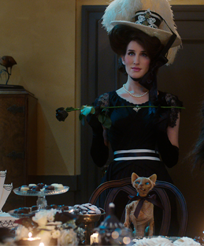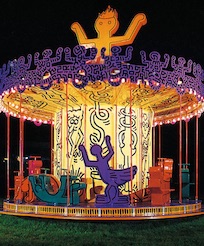I’ve been thinking a lot about fish sex lately, ever since Guillermo del Toro’s The Shape of Water, which stars Sally Hawkins, Michael Shannon, Octavia Spencer and one notable instance of fish sex, became a legitimate Oscar frontrunner, following numerous awards and nominations at the Golden Globes, DGAs, Critics Choice Awards, BAFTAs and more.
I admit that I found the movie utterly unremarkable when I first saw it, a little over a month ago. The film takes place in Baltimore, in 1962, the peak of the Cold War. Elisa (Sally Hawkins), our mute heroine, lives in a flat above a movie theater next door to Giles (Richard Jenkins), an artist who works in advertising—or did, until, one presumes, he was let go for being gay. When Elisa, a cleaning woman at a top-secret government facility, falls in love with a mysterious Amazonian sea creature the U.S. has captured—for warfare-related reasons with the Russians—she conspires to break it out of the compound. At home, in her bathtub, she disrobes in front of our aquatic bachelor, a sculpted, if not briny merman, and engages in what viewers are left to imagine is some form of steamy (salty?) interspecies coitus. Elisa confirms as much to her co-worker, Zelda (Octavia Spencer), who manages to elicit the information on every audience member’s mind: the fish has a cock!
As Katie Knibbs over at The Ringer notes, women fornicating with mythical creatures has a “long, storied history in literature and the arts.” Zeus banged a Phoenician as a bull; as Yeats so eloquently limns in his famous sonnet, he also rapes Leda as a swan. Then there’s the ever-popular Beauty and the Beast, less a myth than a fairy tale, the plot of which relies on a girl falling in love with a shockingly well-dressed bear-like creature—one who can nonetheless totally hold his own on the ballroom d-floor.
The difference between The Shape of Water and those stories, though, is that it’s neither a myth nor a fairy tale—not really. Elisa doesn’t own any anthropomorphic kitchenware. And while the amphibious man may have been worshipped as a god in the Amazon, it’s clear he’s no Zeus. The film incorporates elements of magical realism, certainly, but both its plot and sense of place are resolutely grounded in the Cold War-era tensions between the Americans and the Russians. As Emily Temple, writing about hot fish sex in LitHub puts it, there is an “intellectual logic behind the Russians wanting the monster for experiments related to space travel, but that part of the story inhabits a different world then the monster itself...The world is unbalanced here; it’s working on two separate logical and emotional planes.”
Temple concludes that she cannot buy the fish sex in The Shape of Water. My problem is slightly different: that there isn’t any actual fish sex to not buy. By any estimation, the relationship between Elisa and the fish is an allegory. She is mute; for all intents and purposes, so is he. She falls in love at first sight—a real stretch if this were anything other than an allegory, given he’s literally a monster. Ultimately, theirs is a love between “others” who recognize themselves in one another. “He does not know what I lack or how I am incomplete,” Elisa signs. “He sees me for what I am, as I am.”
This theme has made The Shape of Water a clean, if surprising fit for some members of the LGBTQ community. As Taylor Henderson points out for Advocate, the “heroes of this story aren’t straight white men”; rather, they are three outsiders (a black woman, a mute and a closeted gay man) whose very otherness “binds them together—and saves the creature.” Henderson’s reading is tender and well-put, though it elides a quintessential fact: that the creature is, by his own admission, a “creature,” intrinsically dehumanized the same way “others” have been dehumanized throughout history.
Some might find that analysis nitpicky and unjust. After all, this whole thing is just an allegory, right?
Well, no. The issue with The Shape of Water is that it operates only under the pretense of allegory, just as it only operates under the pretense of myth. The implied fish-fucking is a stroke of pure literalism that belies its central abstraction, knocking the film from its lofty perch as a movie about “otherness” and “soul mates,” and relegating it instead to an altogether different one: a movie about monster sex.
Unsurprisingly, many critiques of The Shape of Water seem to overlook Elisa’s lustfulness. In one of the opening scenes, she’s seen masturbating in her bathtub. We are led to believe this is routine. But her lust for the monster does not fit neatly into an allegory about love, not because lust is not an integral aspect of love, but because actually lusting after a monster is not something most people would be comfortable with. Imagine if del Toro would’ve shown the creature taking Elisa from behind in the shower? Imagine if we’d seen Elisa’s head bowed in front of the creature’s creature-dick? Audiences probably would’ve rushed out of the theater. We certainly wouldn’t be having a conversation about whether this movie was a myth or queer allegory—we’d be talking about it as a movie about fucking monsters. And yet those scenes are precisely the kind del Toro seems to suggest unfold.
Which begs the more interesting question: so what if this is a movie about fucking monsters—or, as Richard Lawson more eloquently puts it, about "sex as release, as communication, as connection confirmed and denied"? Is that not a compelling idea and worthy allegory in and of itself? Perhaps. But in trying to ground a myth in the Cold War-era—in trying mix a high-minded allegory with literal fish sex—del Toro wants to have it both ways. His real accomplishment with The Shape of Water is that, for many viewers, he can.













